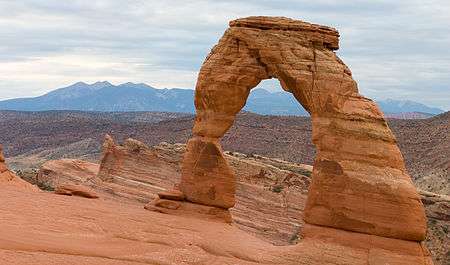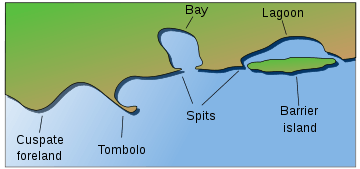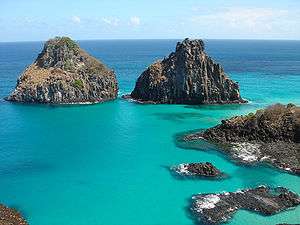Natural arch

A natural arch, natural bridge or, less commonly, a rock arch is a natural rock formation where a rock arch forms, with an opening underneath. Most natural arches form as a narrow bridge, walled by cliffs, become narrower from erosion, with a softer rock stratum under the cliff-forming stratum gradually eroding out until the rock shelters thus formed meet underneath the ridge, thus forming the arch. Natural arches commonly form where cliffs are subject to erosion from the sea, rivers or weathering (subaerial processes); the processes "find" weaknesses in rocks and work on them, making them larger until they break through.
The choice between bridge and arch is somewhat arbitrary. The Natural Arch and Bridge Society identifies a bridge as a subtype of arch that is primarily water-formed.[1] By contrast, the Dictionary of Geological Terms defines a natural bridge as a "natural arch that spans a valley of erosion."[2]
The largest natural arch, by a significant margin, is the Xianren Bridge in China, with a span of 122 ± 5 meters (400 ± 15 ft).[3]
Coastline

On coasts two different types of arches can form depending on the geology. On discordant coastlines rock types run at 90° to the coast. Wave refraction concentrates the wave energy on the headland, and an arch forms when caves break through the headland, e.g., London Bridge in (Victoria, Australia), Neil Island in (Andaman, India). When these eventually collapse, they form stacks and stumps. On concordant coastlines rock types run parallel to the coastline, with weak rock (such as shale) protected by stronger rock (such as limestone) the wave action breaks through the strong rock and then erodes the weak rock very quickly. Good examples of this are at Durdle Door and Stair Hole near Lulworth Cove on the Dorset Jurassic Coast in south England, although these are on an area of concordant coastline. When Stair Hole eventually collapses, it will form a cove.
Weather-eroded arches

Weather-eroded arches begin their formation as deep cracks which penetrate into a sandstone layer. Erosion occurring within the cracks wears away exposed rock layers and enlarges the surface cracks isolating narrow sandstone walls which are called fins. Alternating frosts and thawing cause crumbling and flaking of the porous sandstone and eventually cut through some of the fins. The resulting holes become enlarged to arch proportions by rockfalls and weathering. The arches eventually collapse leaving only buttresses that in time will erode.[4]
Many weather-eroded arches are found in Arches National Park, Canyonlands National Park, and Grand Staircase-Escalante National Monument, all located in southern Utah, United States.
Water-eroded arches

Some natural bridges may look like arches, but they form in the path of streams that wear away and penetrate the rock. Pothole arches form by chemical weathering as water collects in natural depressions and eventually cuts through to the layer below.

Natural Bridges National Monument in Utah protects the area surrounding three large natural bridges all of which were formed by streams running through canyons. The largest of which is named Sipapu Bridge with a span of 225 feet (69 m). The Rainbow Bridge National Monument's namesake was also formed by flowing water which created the largest known natural bridge in the Western Hemisphere with a span of 234 feet (71 m), based on a laser measurement made in 2007. Xianren Bridge, also known as Fairy Bridge, in Guangxi, China is currently the world's largest known natural bridge with a span recorded at 400 feet (120 m) by the Natural Arch and Bridge Society in October 2010, with a precision of ±15 feet (4.6 m).[5][6]
Cave erosion
Natural bridges can form from natural limestone caves, where paired sinkholes collapse and a ridge of stone is left standing in between, with the cave passageway connecting from sinkhole to sinkhole.
Like all rock formations, natural bridges are subject to continued erosion, and will eventually collapse and disappear. One example of this was the double-arched Victorian coastal rock formation, London Bridge, which lost an arch after storms increased erosion.[7]
Arches as highway or railway bridges
In a few places in the world, natural arches are truly natural bridges because there are roads or railroads running across them.
In Virginia, US Route 11 traverses the famous Natural Bridge.
Two additional such arches are found in Kentucky. One, a cave erosion arch made of limestone, is located in Carter Caves State Park and it has a paved road on top. Another, a weather-eroded sandstone arch with a dirt road on top is located on the edge of Natural Bridge State Resort Park in Kentucky. It is called White's Branch Arch (also known as the Narrows) and the road going over it is usually referred to as the Narrows Road.
Another is found in Ponoarele Village, in Romania. It is 60 m long, 13 m wide, features a stone arch 4 m thick, 20 m high, with a 9 m span. It is called God's Bridge (Podul lui Dumnezeu) and it is effectively used for traffic.
The railroad from Lima, Peru crosses the Rio Yauli on a natural bridge near kilometer 214.2 as it approaches the city of La Oroya, Peru
Gallery
-
The Arch of Cabo San Lucas in Mexico.
-
Arch in Timna valley Park in the Negev Desert, Israel.
-

On-bridge, a natural arch in Shōbara, Hiroshima, Japan.
-
Arch Cave on the northern ridge of Nahal Betzet, Galilee, Israel
-

Durdle Door, Dorset, UK
-
Natural Stone Arch in Tirumala, Andhra Pradesh, India
Notable natural arches
Africa
- Aloba Arch, Chad
- Bogenfels, Namibia
- Goedehoop natural rock bridge, South Africa
- Hole-in-the-Wall, Eastern Cape, South Africa
- Wolfberg Arch, Cedarberg mountains, Western Cape, South Africa
- Tassili n'Ajjer, national park in Algeria with many arches
- Tukuyu natural bridge, Tanzania
Asia
- Engetsu-tō, Shirahama, Wakayama, Japan
- Hazarchishma Natural Bridge, Bamyan Province, Afghanistan
- Burdah rock bridge, Wadi Rum, Jordan
- Jabal Umm Fruth Bridge, Jordan
- Jebel Kharaz, Wadi Rum, Jordan
- Moon Hill, Guangxi province, China
- Natural Arch, Tirumala hills, Tirumala, India
- The Howrah Bridge, Neil Island, Andaman and Nicobar Islands, India
- Natural Arch near Badami Caves-Sandstone Hills, Bijapur dist, Karnataka, India
- Paradise Point, Pakistan
- Punarjani Guha, natural tunnel in Thrissur district of Kerala, India
- Arch Cave in the Galilee, Israel
- Rock Bridge of Gulanchwadi, Narayangaon, Maharashtra, India[8]
- Senkanmatsu-shima, Iwami, Tottori, Japan
- Shipton's Arch, Xinjiang, China
- Xianren Bridge, China
Europe
- Arco Naturale, Capri, Italy
- Azure Window, Gozo, Malta
- Bow Fiddle Rock, Portknockie, Scotland
- Castell de Castells, Spain
- Chaos de Montpellier-le-Vieux, France
- Durdle Door, Dorset, England
- Es Pontàs, Spain
- Étretat, France
- Green Bridge of Wales, Pembrokeshire, Wales
- Inland Sea, Gozo, Malta
- Kuhstall, Germany
- Malá Pravčická brána, Czech Republic
- Marvelous Bridges, Bulgaria
- Pistyll Rhaeadr, Wales
- Podul lui Dumnezeu, Ponoarele, Mehedinţi, Romania
- Pont d'Arc, France
- Pravčická brána, Czech Republic
- Kanjon Vratne, Serbia
North America
- Anacapa Island, Channel Islands National Park, California, United States
- Arch Creek Historic and Archeological Site, Florida, United States
- Arches National Park, Utah, United States
- Ayres Natural Bridge State Park, Wyoming, United States
- Bell Smith Springs, Illinois, United States
- Blackwater Natural Bridge, Wyoming, United States
- Bryce Canyon National Park, Utah, United States
- Corona Arch, Utah, United States
- Creelsboro Natural Bridge, Kentucky, United States
- El Arco de Cabo San Lucas, Baja California Sur, Mexico
- Eye of the Needle (Montana), United States
- Goat Rock Beach, California, United States
- Grosvenor Arch, Utah, United States
- Koger Natural Arch, Kentucky, United States[9]
- Kolob Arch, Zion National Park, Utah, United States
- Landscape Arch, Utah, United States
- Lost Creek Wilderness, Colorado, United States
- Natural Bridge, Aruba (collapsed 2005)
- Natural Bridge (Virginia), United States
- Natural Bridge Caverns, Texas, United States
- Natural Bridge Park, Alabama, United States
- Natural Bridge State Park (Kentucky), United States
- Natural Bridge State Park (Massachusetts), United States
- Natural Bridge State Park (Wisconsin), United States
- Natural Bridges National Monument, Utah, United States
- Natural Bridges State Beach, California, United States
- Percé Rock, Quebec, Canada
- Rainbow Bridge National Monument, Utah, United States
- Rattlesnake Canyon (Colorado), United States
- Sewanee Natural Bridge, Tennessee, United States
- Sipapu Bridge, Utah, United States
- Three Arch Rocks National Wildlife Refuge, Oregon, United States
- Tonto Natural Bridge, Arizona, United States
- Wrather Arch, Arizona, United States
Oceania
- London Arch, Australia (collapsed 1990)
- Mangapohue Natural Bridge, New Zealand
- Oparara Basin Arches, New Zealand
- Piercy Island, New Zealand
- Springbrook National Park, Queensland, Australia
- Tolaga Bay and Pourewa Island, New Zealand
South America
- Arch Islands, Falkland Islands
- Icononzo, Colombia
- La Portada, Chile
- Puente del Inca, Argentina
- Sete Cidades National Park, Brazil
Other
- The Arch of Kerguelen, Christmas Harbour, Kerguelen Islands (collapsed ca. 1910)[10]
See also
References
- ↑ Natural Arch and Bridge Society, FAQ.
- ↑ American Geological Institute, Dictionary of Geological Terms, 1976, Doubleday Anchor
- ↑ Big 14 Tour - Fairy Bridge, The Natural Arch and Bridge Society
- ↑ "Geology Resources, Arches National Park". National Park Service. Retrieved 2015-12-23.
- ↑ Jett, Stephen C.China Diary, The Natural Arch and Bridge Society
- ↑ Measurement of Fairy Bridge
- ↑ Trek Earth
- ↑ Offbeat Tracks in Maharashtra - A Travel Guide - Book by Milind Gunaji ISBN 81-7154-669-2
- ↑ "Natural Arch". Kentucky Society of Professional Geologists. Retrieved 2015-12-23.
- ↑ "Kerguelen Islands, Part 1," DiscoverFrance.net
External links
| Wikimedia Commons has media related to Natural arches. |


